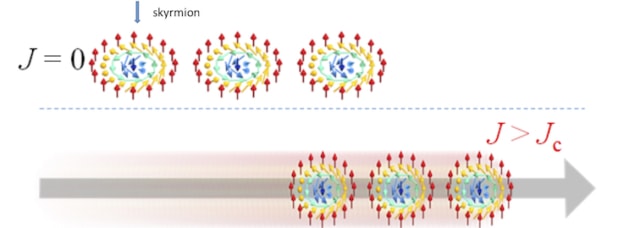
Magnetic skyrmions – quasiparticles with a vortex-like structure – show much promise as storage bits for next-generation computer memories and logic devices, but tracking their motion is no easy task. Researchers at the RIKEN Center for Emergent Matter Science in Japan have now succeeded in tracing them using small pulses of electric current – a development that brings real-world devices based on skyrmions a step closer to reality.
Skyrmions can be thought of as 2D knots (or “spin textures”) in a material in which the magnetic moments rotate 360° within a plane. They exist in many structures, notably magnetic thin films and multilayers, and are very small, measuring just tens of nanometres across.
Because skyrmions are much smaller than the magnetic domains used in modern disk drives, and also robust against external perturbations, they are considered ideal building blocks for future magnetic data storage technologies such as “racetrack” memories. In these devices, spin currents (which consist of electrons with opposite spins moving in opposite directions) are used to “push” a magnetic domain past magnetic read/write heads. A skyrmion could replace a magnetic domain and serve as a substitute information carrier (a “1” in the binary system of 1s and 0s)
There is a drawback, however, in that it is difficult to measure skyrmions without using large electric currents. This is because of their small size, which makes them crystallize in an energetically stable close-packed hexagonal lattice that is hard to budge.
Making use of a helimagnet
In their experiments, a team of researchers led by Xiuzhen Yu studied thin films of iron germanide (FeGe). This material is magnetic, but not in the usual ferromagnetic sense of having all the magnetic moments within each domain aligned in the same direction. Instead, it is helimagnetic, meaning that the magnetic moments within its domains are arranged in spiral or helical patterns. These unusual patterns make it easier to manipulate the skyrmions in the magnet, as the magnetic moments follow the spiral patterns.
Yu and colleagues began by etching a square notch in their FeGe film to generate localized spin current around the corner of the notch. To create and then erase single skyrmions and skyrmion clusters in the film, the researchers applied pulses of electric currents first in one direction relative to their notched films and then in the opposite direction. By then recording the results using a technique called Lorentz transmission electron microscopy, they found a point in the material at which they could isolate individual skyrmions (measuring just 80 nm in size) and record how they moved based on known processes such as the topological Hall effect. This effect occurs when a voltage is applied along a thin conducting sheet of material while a magnetic field is applied perpendicular to its surface.
Relatively low electric current
The electric currents that the researchers applied to create and move the skyrmions in FeGe are very weak, around 109 A/m2, which is a thousand times lower than that required for traditional magnetic domain wall hard drives.

Skyrmion bags point the way to high-density data storage
“Our result demonstrates that it is possible to manipulate and track individual skyrmions and skyrmion crystals (which contain a number of vortices and are thus difficult to move) using a relatively low electric current,” Yu says. “Such detection is an important step towards real-world applications based on these particles because it would correspond to the reading procedure in a skyrmion-based logic device.”
Members of the team, who report their work in Science Advances, say they are now developing a bilayer system of FeGe films that could host combined skyrmions, which might be easier to detect. “We are also eager to track skyrmions in one-dimensional structures such as nanowires (which would mimic a racetrack structure) at room temperature,” Yu tells Physics World. “The challenges here will be nanofabrication and device design.”



